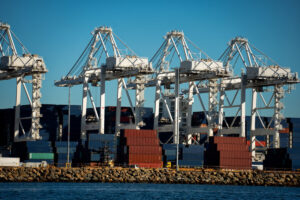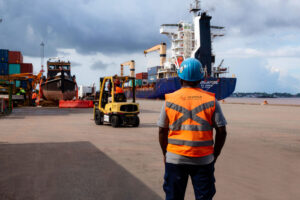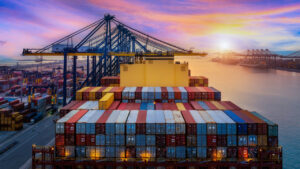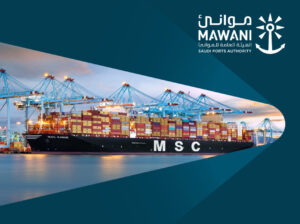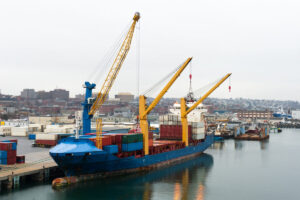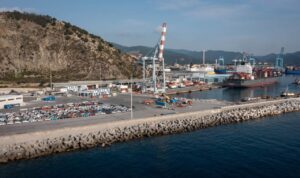Port Technology has brought its audience a smorgasbord of insight on port-related topics this year, and to wrap up a very successful 2017, we've decided to celebrate by revealing the top 10 most-read list below.
Port Technology has covered the subjects 'Cyber Risk & Security' (edition 76), 'Mega-Ports & Mega-Terminals' (edition 75), 'AI & Automation' (edition 74) and 'The Automation, Training & Simulation Issue' (edition 73), but, after more than 120 technical papers…
'Blockchain Technology for Ports' by Wolfgang Lehmacher, Head of Supply Chain and Transport Industries, World Economic Forum, has come out on top.
There is probably not a single person involved in the shipping industry that hasn't heard about blockchain by now, but the same can't be said about how well these same professionals understand the potential benefits of the technology.
By reading Lehmacher's paper, you will understand the suitability of blockchain and blockchain-based distributed ledger technology (DLT) to the port, harbour, and terminal industries.
It explains how DLT has the potential to drastically change the world of asset transfer, asset movements and security of data movement.
Lehmacher has examined how the testing of various DLT applications has already started – first in 2009 with the emergence of Bitcoin in the financial services industry, then subsequently in various other fields, including within the supply chain.
He has also stressed how important it is for executives in the port, harbour and terminal industries to understand the potential impact and implications of DLT and blockchain – in business, in respect to government interactions, and along the supply chain.
#2: Liner Shipping in 2025
Author: Lars Jensen, CEO, SeaIntelligence, Copenhagen, Denmark
Edition 74 – AI & Automation
With the turmoil of 2016 barely behind us, it could appear overly optimistic to attempt to forecast the industry’s developments as far in to the future as 2025. That is nonetheless the focus of my new book entitled LinerShipping 2025 – how to survive and thrive. In this paper I will offer a review of some of the key elements of the book.
The industry is currently facing a fundamental transformation which will profoundly change the existing business models – and that this transformation will happen irrespective of the practical details, such as demand growth and freight rate developments. Let us contemplate four of the main driving forces: digitization, transparency, supply-chain dispersal and network optimization…
#3: Maintenance of Automated Terminals
Author: Arto Keskinen, IIkka Annala, Peter Miedema, Kalmar Global
Edition 73 – The Automation, Training & Simulation Issue
When converting a manual container terminal to automation, the first thing that comes to mind is installing automated equipment and building the infrastructure needed to run it.
However, to ensure the terminal is running optimally, the services and maintenance of an automated terminal also needs proper attention. This focus must begin in the planning phase, continue through the deployment and start-up periods, and extend into maintenance planning and optimisation over the lifetime of the terminal…
#4: How Technology Transforms Ocean Container Shipping
Author: Inna Kuznetsova, Jeff L. Howard and Peter Spellman, INTTRA
Edition 73 – The Automation, Training & Simulation Issue
Over the past 15 years, the ocean logistics industry experienced vast changes to business models, services and technology adoption. In 2016, the pace of technology innovation accelerated as participants sought business model optimisation. Digitalisation is now a competitive necessity. This trend will continue in the next 15 years, creating new opportunities – and winners and losers. In this paper, INTTRA outlines our vision for the direction of information technology-driven innovation from our vantage point as a neutral service provide…
#5: Empty Container Repositioning
Author: Professor Rob Zuidwijk, Rotterdam School of Management, and Professor Bart Wiegmans, Delft University of Technology
Edition 74 – AI & Automation
The global distribution of goods involving maritime transport makes use of standardized loading units, which are also known as maritime containers, progressively. It is not uncommon to use these containers beyond the transport between seaports, i.e. the goods are transported in containers from origin to destination in the hinterland, e.g. from supplier factory to buyer distribution centre…
#6: Are TOS Systems Efficient Enough for SMTs?
Author:Marc Boyer Chammard, CEO, TGI Maritime Software
Edition 73 – The Automation, Training & Simulation Issue
TGI often see press releases selling breakthroughs and innovations happening at large terminals, usually heavy investment in equipment, infrastructure or IT, and its flagship product in the maritime terminal industry: The TOS (Terminal Operating System). But innovation isn’t just restricted to the large players in the industry, small and medium sized terminals (SMTs), with relatively small investments, can also benefit from TOS and providers dedicated to this SMT market…
#7: Automated Intelligence
Author: Rich Ceci, Port of Virginia, Virginia, US and Oscar Pernia, Navis, Rotterdam, Netherlands
Edition 74 – AI & Automation
Why is realizing the full potential of automated terminals for operational performance taking so long? And, for those who succeed in automation, why is it so complex and difficult?
In the ‘promised land’ of terminal automation, the missing piece is the confidence in regards to how robots, software and humans, performing as a whole, will achieve greater levels of operational performance. Automated decision making is a fundamental piece of that ‘promised land’; automated or not, decisions at container terminals must be prescriptive, looking ahead to better deal with the inherent dynamics of planning. They must also be resilient, adapting to addressing the required flexibility at execution…
#8: The VGM Ruling: A Review of the Implementation
Author: Peregrine Storrs Fox, Risk Management Director, TT Club, London, UK
Edition 74 – AI & Automation
The much-trumpeted container weighing regulation which exercised much of the freight industry last year is hoped to be the mere overture to a concerted effort to bring about significant behavioural change. This paper assesses the degree of compliance with the VGM regulation that has been achieved but also looks forward to what needs to be done to further ensure safety and sustainability in the global supply chain…
#9: Automatic Twistlock Systems
Author: Dr Mi-Rong (Kimberly) Wu, Project Manager, TBA, Netherlands
Edition 74 – AI & Automation
The current practice at container terminals is to manually remove twistlocks from containers – a time consuming activity. This process can be automated, which saves time, reduces risk at the terminal and contributes to a more efficient operation.
The removal of the twistlocks takes on average 15-20 seconds. When this process can be skipped, the cycle time of quay cranes can be significantly reduced. Besides this gain at the quay crane, the container positioning in the stack can be executed much faster also…
#10: A New Dawn for Crane Technology
Author: David Moosbrugger, Managing Director, Kuenz
Edition 74 – AI & Automation
The future in the container handling industry is automation. We know that the basis for a well working automated crane is a proper mechanical concept and key performance indicators.
We measure these on the mechanical side (stiffness of the crane and rope tower), via intelligent travelling drive units, accurate manufacturing of all components and self-adjusting systems (such as rope adjusting during lifting)…











